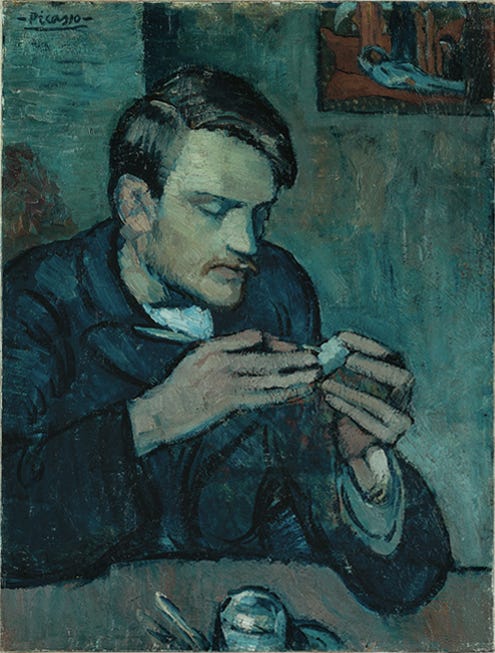On the vexing timing of the Rudy Gobert trade
Why did Tim Connelly make such a hasty, era-defining trade as his first order of business running the Wolves?
Good morning. Long email rich with clips, so click the headline to open in a browser or use the Substack app. Let’s basketball.
Portrait de Mateu Fernández de Soto, Pablo Picasso, 1901
As someone who was less skeptical than the rest of the NBA analyst class regarding the Timberwolves’ massive trade for Rudy Gobert last summer, one thing continues to vex me: the timing. Tim Connelly was hired by the Timberwolves on May 23 and given an enormous contract for a general manager of his stature (which is to say, he wasn’t Masai Ujiri, Bob Myers or Pat Riley).
The Jazz, Timberwolves and Connelly’s Nuggets had all been out of the playoffs for a month. Murmurs were circling Quin Snyder’s future in Salt Lake City, but he didn’t resign for another two weeks. It became clear early that the Jazz were looking at young coaches for their vacancy, though Will Hardy wasn’t hired until the end of June. The Gobert trade broke on July 1.
Lots of folks have asked why Connelly traded so much draft equity plus some important role players for a second center, one who is 30 years old, limited in certain ways, and has a history of not vibing with his star guard. And all of that is obviously fair to ask, now more than ever. It looks like a massive blunder from the person responsible for drafting Nikola Jokic, Jamal Murray and Michael Porter Jr., the person responsible for trading for Aaron Gordon, the person most responsible for building the team that is currently tied for No. 1 in the Western Conference.
But I’m really stuck on why Connelly took his huge shot so quickly into his tenure in Minnesota. A month! He had been in Minnesota a month when he made what could be (for better but probably worse) an era-defining transaction. Connelly had the blessing of time based on his reported 5-year, $40 million contract. He could have explored Anthony Edwards’ near-term potential for growth, how Karl-Anthony Towns could be more complete, what the market was for D’Angelo Russell, what pieces need to augment the rising roster. Instead, he went all-in on an opportunity that surprisingly came onto the table. He found the Jazz exiting the Gobert business, and decided he wanted nothing more than that, in the process hamstringing his future ability to adjust.
Trading all those picks for a player like Gobert is typically the province of a short-term GM, someone who needs to get instant improvement or get the boot. Connelly was in exact opposite situation when he pulled the trigger. Perhaps no GM in the league was in better position to be patient than Connelly on July 1, 2022, as he was negotiating the finer points of the trade.
What made him do it, truly? Was it pure excitable opportunism? Did his job security make him feel like now was the perfect time to take a huge risk, with the self-belief to know he could climb out of it with second-round picks and adept trades and signings should it not go perfectly? Was he so unconvinced of Towns’ long-term fit next to Edwards that he hastened the end of the experiment by bringing in a different type of center immediately? Why then? Why this?
To me, it’s the most fascinating question about the Gobert trade1, one for which we won’t get the honest answer for years and years, if ever.
Keep reading with a 7-day free trial
Subscribe to Good Morning It's Basketball to keep reading this post and get 7 days of free access to the full post archives.



